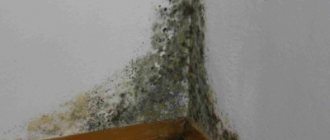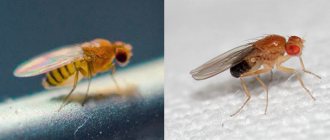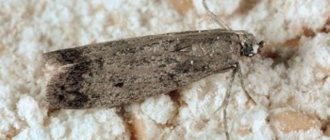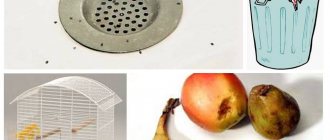Let's remember biology: types of fruit flies
The insect is harmless, although annoying.
Scientists count several thousand species, although only 1,500 of them are described in detail, 40 live in European countries. Drosophila melanogaster (other names: fruit fly, fruit fly, small fly, wood sorrel) is a small, approximately 3 mm in length, insect belonging to the family Drosophiliadae, order Diptera. External characteristics: red eyes and brown-yellow coloration with black rings on the abdomen. The female's body is approximately 2.5 mm, while the male is smaller and has a darker rear. It is these midges that usually appear in houses and apartments.
By the way, the melanogaster subspecies is highly valued by geneticists because it is ideal for experiments.
And especially for aquarists, a wingless subtype has been bred, which is used to feed fish and reptiles.
Drosophila funebris (called the large or vinegar fly) is larger than melanogaster by an average of 1 mm. It lives mainly near ponds, barrels or other vessels with fermenting/rotting liquids, and less often found in fruits.
Insect lifestyle
Drosophila are also called vinegar flies or wine flies. They belong to the order Diptera, the family of fruit flies. Today, about 1,500 species of these insects are known. They are widespread in the southern and temperate climate zones, but are also found much further north. The flies get there with fruits and vegetables.
Drosophila is an insect whose length is about 3 mm. She has red eyes and a yellow belly. In males it is oblong with a dark tip, while in females it is light and pointed. Males are slightly smaller than females.
Flies feed on fermented fruits, plant juices, and rotting plants. In the south, many fruit flies are found in gardens and vineyards. There is no fight against them, since they do not cause harm. In the temperate zone, flies live in vegetable stores, fruit warehouses, fruit processing plants, and wine production.
Flies appear on the street when the temperature rises above +16 ºС. In warm weather and high humidity, their numbers grow rapidly. During the cold period, they hide in closed heated rooms: in warehouses, retail outlets and apartments.
What does it look like
They are small flies, usually pale yellow to reddish brown, black in color with red eyes. Many species have distinct black patterns on their wings. Most are 2–4 mm long, but some are larger than house flies .
They have three frontal setae on each side of the head, one directed forward and the other two directed backward.
How to wash berries from insects
Before eating, the berries must be washed with running water.
How to completely remove insects:
- Soak in a weak solution of vinegar (a tablespoon per liter) for three to five minutes.
- Soak the berries for 20–30 minutes in water. The liquid will force the worms to leave the fruit.
- Soak in a solution of table salt for 15-30 minutes.
The result will be as in the photo. The small dark stripes are dead larvae.
Drosophila flight
The wings of the fly are capable of oscillating at a frequency of up to 250 times per second. Flight consists of direct translational movements alternating with rapid turns called saccades. With such rotations, the front sight is able to rotate 90 degrees in less than 50 milliseconds.
Fruit flies, and probably many other flies, have optic nerves that go directly to the muscles of their wings (whereas in other insects they always go to the brain first), which dramatically speeds up their reactions.
For a long time it was thought that the flight characteristics of fruit flies were determined by the viscosity of the air, and not by the inertia of their body. Recent research by Michael Dickinson and Rosalyn Sayaman has shown that when a fly makes a turn, it first speeds up, then slows down through the turn, and then speeds up again at the end of the turn. This shows that inertia is the dominant force here, as is the case with large flying animals.
Where do fruit flies come from?
Before you get rid of fruit flies, you need to know the reasons and ways of their appearance in the house.
All year round, pests live mainly in warm regions of the country. However, in summer, flies are ubiquitous, and even in winter, residents of the middle zone are not immune from their invasion.
Spoiled fruits and vegetables become food for fruit flies, so flies live where there is an abundance of food, and rotten ones at that. Insects do not disdain animal feces, which poses a particular danger to humans. The main habitats of fruit flies are:
- garbage cans, landfills, landfills;
- greenhouses, gardens, vineyards;
- fruit bases;
- places where livestock gather;
- houseplants.
Drosophilas usually don’t settle in houses just like that; this requires favorable conditions. Open juices, wines, spoiled fruits, vegetables, their improper storage, improper care of plants, non-compliance with sanitary and hygienic standards, irregular cleaning in the apartment - all this can lead to clouds of flies, which are very difficult to get rid of.
Drosophila appear indoors in the following ways:
- through ventilation;
- together with fruits, especially spoiled ones;
- on the fur of pets if they walk outside;
- through windows, vents, doors;
- with soil for indoor plants, brought flowers.
It is worth noting that fruit flies do not fly far, so adult flies can appear in an apartment only if there are food depots, landfills and greenhouses near the house. Most often, these pests enter a person’s home in the form of eggs, reaching a size of no more than 0.5 mm, on vegetables, fruits, clothes, wool, etc. Therefore, it will not be possible to completely protect the apartment from insect invasion.
Advice! To prevent the appearance of fruit flies in the house, you need to carefully select products in the store and buy only fresh fruits and vegetables.
Life cycle
Drosophila flies are found throughout the world, with a large diversity of species in tropical regions. They can be found in deserts, tropical forests, cities, swamps, and alpine areas. Some northern species overwinter. Most reproduce on decaying plant and fungal materials:
- fruits;
- peel;
- flowers;
- mushrooms.
D. suzukii larvae feed on fresh fruit and are sometimes pests. Several species have evolved into parasites or predators. Many are attracted to fermented banana or mushroom baits, others are not interested in baits. Males gather on areas of the substrate to compete for females.
D. melanogaster, D. immigrans, D. simulans are closely related to humans and are often referred to as domestic species. They are distributed throughout the world as a result of human activities such as the transport of fruit.
Females and males
Females differ from males in morphological characters:
- Females are larger, although their size may be influenced by nutrition and the period of larval development.
- The shape of the abdomen in females is round with a sharp tip, in males it is cylindrical with a rounded end.
- The number of sternites (surface chitinous scutes) in females is 8, in males for involvement in the process of wing movement - 7.
On the left is a female, on the right is a male.
Help: you can understand whether it is a male or a female by examining their abdomen under a microscope. Males have black lines and thin setae near the tarsus, which are necessary to hold the female during the mating process. Females have 5 stripes on their abdomen, males have 3. At the end of the abdomen, males have a dark spot, while females have thick black stripes.
Egg
The female insect lays eggs, which are about 0.5 mm in size, into rotting fruit or other organic material.
Determination of gender
Drosophila are characterized by XY sex determination. Unlike humans, in Drosophila sex is determined not by the presence of a Y chromosome, but by the ratio of the number of X chromosomes to the number of haploid sets of autosomes. With a ratio equal to 1, the individual develops into a female, and with a ratio equal to 1/2, into a male [comm. 1] . In case of violations, infertile individuals are formed: the so-called intersex (if this ratio lies between 1/2 and 1), super males (ratio less than 1/2) and super females (ratio greater than 1). The presence of the Y chromosome does not affect sex in any way, but males without it are sterile, since it contains the genes responsible for spermatogenesis.
Number of X chromosomes Number of haploid sets of autosomes Ratio of the number of X chromosomes to the number of haploid sets of autosomes Sex (phenotype) [5]
| 3 | 2 | 1,5 | Superfemale |
| 4 | 4 | 1 | Female |
| 3 | 3 | 1 | Female |
| 2 | 2 | 1 | Female (normal) |
| 2 | 3 | 0,(6) | Intersex |
| 1 | 2 | 0,5 | Male (normal) |
| 1 | 3 | 0,(3) | Supermale |
The key gene in determining the sex of Drosophila is the sex-lethal (sxl) gene. It is the difference in alternative splicing of this gene that gives rise to differences between the two sexes. The so-called numerator genes (sis-a, sis-b (sisterless-a, sisterless-b), runt (runt)), localized in the X chromosome, and denominator genes ( denominator) (dpn (deadpan), da (daughterless), emc (extramacrohaeta), etc.), localized in autosomes. Both of them are transcription factors, the ratio of which determines the alternative splicing of the sxl gene. Activators (numerators) and repressors (denominators) are capable of forming complexes. Depending on the ratio of the number of these genes, the activators will either overcome the action of the repressors, or the repressors will suppress the activity of the activators. In the first case (with the ratio X_A=1, the genotype is female), the sxl gene will begin to be read from the proximal (early) promoter. Then, during alternative splicing, the active protein product sxl will be formed, which is a splicing factor and, by binding to its own pre-mRNA, fixes this splicing variant. In another case, if repressors suppress activators (ratio X_A = 0.5 - male genotype), transcription of sxl will begin from the distal (late) promoter. In this case, an inactive protein is formed, since the “male exon” (third), in which the UGA stop codon is located, is not cut out, preventing the formation of full-fledged mRNA.
The female sxl protein product is an active splicing factor not only for its own RNA, but also for the pre-mRNA of the transformer (tra) gene. In males, sxl is inactive as a splicing factor, so the product of the transformer gene is also an inactive protein.
The next step in the cascade is the Doublesex (dsx) gene. In females, the tra protein (together with tra-2, which functions in both sexes) modifies its splicing, which leads to the formation of the DsxFem protein (female variant). In males, this modification does not occur; splicing occurs differently, and a different protein is formed - DsxM (male version). These proteins are transcription factors that influence the activity of genes responsible for the development of phenotypic sex.
Economic significance
Drosophila flies are considered more of a nuisance than a pest because most breed on rotting materials. Zaprionus indianus Gupta is unusual and is a major pest of figs in Brazil.
Another species, Drosophila suzukii, infects thin-skinned fruits such as raspberries and cherries, a serious agricultural pest.
Drosophila repleta larvae live in drains and spread bacteria. Flies are considered a common carrier of acetic acid bacteria. They often destroy the fermentation process of alcohol, spoiling beer or wine, turning them into vinegar.
Drosophila reproduction
The fruit fly goes through three stages in its development, characteristic of all dipterous insects:
- Eggs laid by a female
- Larvae
- Adult Drosophila
Insect eggs and larvae are adapted to live in a semi-liquid environment. The female fruit fly lays eggs on half-decomposed fruit or other growing medium. They stay on the surface thanks to special float chambers. The eggs are about 0.5 mm in size. Larvae hatched from eggs are white and up to 3.5 mm long. A sufficient amount of food during this period of development is crucial; the size and viability of the emerging flies depends on this. At first, the larvae swim on the surface of the nutrient medium, then go deeper and remain there until pupation. After four days, young fruit flies emerge from the pupae and become sexually mature after eight hours. Female fruit flies begin laying eggs on the second day and carry out this process for the rest of their lives. At one time, the female usually lays 50-80 eggs.
How do fruit flies reproduce?
Where do fruit flies lay their eggs? The female insect lays eggs, the size of which is about 0.5 mm, in rotting fruit or any other organic material. After approximately 10 days, white larvae hatch, measuring up to 3.5 mm in size.
At first they are on the surface of the breeding site, then they go deeper, where pupation occurs. After 4 days, adults appear - imagoes, which reach sexual maturity within 8-12 hours.
Are fruit flies dangerous?
The flies themselves are not dangerous to humans: they do not bite, since their jaws are simply unable to bite through even the thinnest skin.
Flies are annoying with their flickering, they constantly come to hand.
However, this is not the most unpleasant consequence that an insect invasion leads to; the danger of fruit flies lies elsewhere. Pests feed on organic matter, including waste from landfills and animal feces, and their sweat. They can contain dangerous bacteria, which flies carry on their legs or proboscis and then leave on food.
Thus, a pathogenic bacterium can enter the human body, which, if the immune system is weakened, will lead to intestinal infections. In addition, eating food with fruit fly eggs on the surface causes diarrhea and nausea, accompanied by a rise in temperature.
What is the harm of a fruit fly and is there any benefit from it?
Drosophila do not bite, do not suck blood, and do not transmit diseases. In general - harmless. But, hovering in a swarm over a rotting fruit or houseplant, they flicker before your eyes and create special discomfort.
The harm from flies is one thing: if you eat spoiled fruit infected with larvae, you can get intestinal upset.
Drosophila are valuable material for conducting research and experiments, studying genetic mutations and mechanisms of inheritance. The whole point is in the peculiarities of the genetic apparatus of insects, which has similarities with humans. Experts use flies to recognize the mechanisms of serious diseases (Parkinson's, Alzheimer's, diabetes, drug addiction, cancer) and to develop new therapeutic drugs to which fruit flies are sensitive.
Fruit flies are so small that they would go unnoticed by humans if not for their intrusive lifestyle. You can also understand that they have really started up in the apartment when spoilage or areas of rotting appear on fruits and vegetables. If the food begins to rot, then the female insect has probably laid eggs in it or larvae have already appeared.
How to get rid of fruit flies in an apartment?
You can get rid of fruit flies using folk and special remedies. It is best to take a comprehensive approach to solving the problem, otherwise the invasion of flies will repeat itself after a while.
To effectively get rid of insects, you should:
- Figuring out where flies breed and live is where you need to make the most impact.
- Clean the kitchen: throw out spoiled food, clean out trash cans and drains.
- Comply with all food storage conditions.
- Remove fallen, dry leaves from indoor plants, and put rotten flowers in the trash can.
- Wash pets' bowls thoroughly, especially if they contained plant-based foods.
- Treat the kitchen with anti-fly products, paying attention to their habitats.
Attention! The most important step when trying to breed fruit flies is to eliminate their source of food, because without food they cannot survive for long.
Traps
You can get rid of flies using traps; this is one of the simplest and most effective ways. To fix the problem, you need to do the following:
- Choose bait. It can be any spoiled fruit, but it is best to take bananas, apples, honey, and berries. Drosophila are also not against enjoying juices and jams, apple cider vinegar. An excellent solution would be to use fruits that have already been eaten by flies for the trap, because in any case you will have to throw them away.
- Next, you need to place the selected bait in a plastic bag and leave it open in the kitchen, preferably in the place where insects fly most.
- For greater efficiency, you can close the bag, but make small holes in it so that pests can get inside. It will be difficult for them to fly back.
- When a large number of individuals are trapped, you should quickly close the bag if it was open.
- Then you need to throw the trap in a landfill; do not leave it in the trash. If the bag accidentally breaks, the flies will become free and the fight will have to start all over again.
You can make a trap in another equally effective way:
- Cover the bottom of a glass jar with a thick layer of jam or honey.
- Place a sheet of paper rolled into a cone inside so that the narrow end comes out of the opening of the jar.
Attracted by the smell of “goodies,” the flies will crawl into a small hole, but will not be able to get out of it.
There is a third method that will help get rid of annoying flies. It is necessary to mix equal amounts of sweet liquid bait and any detergent, for example, for dishes. Cover a cardboard or an unnecessary plate with this mixture and place it in the kitchen. The flies will eat the bait, and the dishwashing liquid will act as poison.
Chemicals
Professional means will help destroy fruit flies much faster and more effectively than traditional methods and traps. However, some types of chemicals are quite toxic and can cause allergic reactions. Therefore, before using such drugs, carefully read the instructions.
There are many means to help get rid of fruit flies, among them are:
- Raptor. Works on the same principle as traps. It is a sticky tape, the surface of which is treated with a sweet odorous substance that attracts flies. Once on the Velcro, the Drosophila cannot get out of it. This product perfectly helps to get rid of both flies and other types of insects: ants, house flies, mosquitoes.
- Dichlorvos. It is produced in the form of an aerosol, which is sprayed in the habitats of fruit flies. It is noteworthy that Dichlorvos is odorless and is also suitable for getting rid of other types of pests. Before using the spray, you should remove any products that may be exposed to particles. After completing the procedure, you should thoroughly ventilate the room.
- Combat is a fumigator that comes with insect repellent liquid. For the device to start working, you need to connect it to an outlet. Toxic fumes have virtually no effect on humans, but they are good at getting rid of house flies, mosquitoes and midges. However, you should not leave the fumigator near the bed, in the bedroom while sleeping, or in the nursery.
Since most chemicals are quite toxic, do not forget about the following precautions:
- Wear thick protective rubber gloves and a mask when using sprays.
- Keep the sprayed product at arm's length, as far as possible from the respiratory system and mucous membranes.
- If there are symptoms of poisoning (nausea, dizziness, weakness), quickly remove the clothes in which the treatment was carried out, wash your hands thoroughly, rinse your mouth and drink 3-4 tablets of activated carbon.
- If your condition worsens, consult your doctor immediately.
Fighting methods
Drosophila flies appear in a person’s home in various ways, so you need to know how you can get rid of an unpleasant neighborhood. Of course, insects do not bite, but few housewives will like the fact that hordes of midges feel comfortable in her kitchen. Therefore, you can and should fight flies, and you should start not with chemical industry products, but with simple folk methods and advice.
The first step is to find and destroy their food source . It could be rotten carrots or onions that were lying on the back shelf of the pantry, happily spoiled and were forgotten. It is also possible that the pests attacked a bag of garbage that no one had taken out for a long time. Therefore, it is necessary to carefully examine the room where fruit flies swarm and bring it into perfect order. If you have a habit of watering indoor flowers or seedlings planted in the spring, you should give it up.
Making traps and traditional methods
Experts also recommend using homemade baits, but leave Dichlorvos only as a last resort. Making basic and easy-to-use devices for exterminating small pests is quite simple. You can use available tools:
- Take a bag, put peelings or a couple of rotting apples in it, place it open in the place where the midges swarm. After 20-30 minutes, they, attracted by the coveted food, will penetrate inside the bag, so the owner will only have to quickly tie the trap and throw it away.
- You can also use a juice bag: place it open in the fruit fly habitat, leave for 30 minutes, then close the lid and take it to the trash.
- If pests have accumulated in large numbers in the kitchen, you should place shallow saucers with jam in several places, then wait until the flies stick to it, then throw it away.
An effective trap can be easily constructed from various materials, the main thing is that the bait can be placed inside. For this purpose, you can use wine bottles, beer cans, and plastic cups.
Insects cannot stand strong pungent odors, so you should fumigate the room where they bred with the aroma of lavender, incense, lemon or orange, conifers, and tansy.
It is enough to buy essential oil and use an aroma lamp so that the pests quickly leave the kitchen. For preventative purposes, it is necessary to place bouquets of tansy and wormwood in the corners of the pantry; fruit flies also do not like the aroma of these plants.
Preventive actions
It is easier to prevent a problem from occurring than to put effort into solving it, so it is very important to pay due attention to prevention. In the apartment, and especially in the kitchen, you should keep it clean, take out the trash on time, put all food in the refrigerator, do not store rotten fruits or vegetables, keep an eye on your pets’ bowls, and do not forget to periodically put them in order. Remove or throw away uneaten food.
It is recommended to wash dishes immediately after eating, avoiding their accumulation in the sink, and wipe tables with a clean, well-wrung out rag.
Experts do not recommend using tea leaves for watering indoor plants: it rots and becomes a favorable environment for midges. Also, do not allow water to stagnate in the trays.
The Drosophila fly, despite its small size and harmlessness, can cause a lot of harm. In addition, the insect has a very fast reproduction rate, therefore, if you find a swarm in your home, you should immediately begin to destroy it, otherwise the number of pests will grow exponentially. Having dealt with fruit flies, you need to maintain order in the future so that they do not appear again.
How do fruit flies appear in an apartment?
Drosophila are not adapted to long flights, covering no more than 200m per day. Occur indoors from nearby places:
- earth (soil) taken from the site for planting indoor flowers;
- fruit and berry trees, plantings;
- garbage dumps, dung heaps;
- rotten foods (fruits, vegetables);
- pet food;
- other raw materials from sour yeast cultures.
Flies fly into the apartment through ventilation and open windows. Their favorite habitat is trash cans and places where food waste is stored. Often people themselves bring fruit flies into their apartments in the form of deposited larvae along with food from the market.
Females lay up to 400 eggs per day, so they reproduce instantly. It happens that one fly settles in a spoiled fruit. After a day (if the product is not disposed of on time), a whole horde of annoying insects appears in the room. Drosophila are travelers. They can appear in an apartment with vegetables and fruits brought from the south. Large accumulations can be observed in fruit factories, warehouses and vegetable stores, in wine cellars with large quantities of fruit juice and canned fruits.
The flies are small and cunning. They hide in pots with indoor flowers when they are being hunted, for example in the kitchen near food. Drosophila love to flock to sweet juices and fruits, hence their name - fruit.
Entomological description
Drosophila flies, or fruit flies, are small in size, their body length does not exceed 2.5-3 mm, color is brown-yellow (less often gray), black stripes are visible across the abdomen. Males are noticeably smaller than females, which shows the sexual dimorphism of insects. In addition, the following characteristics of the species can be distinguished:
- Red reticulated eyes, however, due to their small size, this feature can only be seen under a microscope.
- Males have a completely black tip on the abdomen, as well as pointed setae.
- The wings are longer than the body. But, despite the presence of wings, they fly very poorly, covering a distance of less than 200 m per day.
Insects are quite common, found throughout Russia, but there are especially many of them in southern latitudes. As a rule, they penetrate to the north along with imported vegetables and fruits. The average lifespan is 30 days , but with favorable temperature conditions, flies can live for 60 days.
The female is incredibly fertile: in such a short life span she is capable of laying several hundred eggs, but not all of them will produce worm-like larvae. Development to an imago—an adult—occurs in 10 days, which is why baby fruit flies are able to colonize a room they accidentally enter in a very short time.
Rotten vegetables and fruits are used as food , so another name for the insect is fruit fly. They also eat tree sap, jam, wine pomace (which is why they are also called wine flies) and numerous types of waste. In general, their favorite treat is fermented products. Insects are susceptible to sour odors, so they quickly attack a room containing waste and rotting crops.
Why destroy them?
These pests live longer than you think. There is a myth that fruit flies live and die within 24 hours. It turns out that the life cycle can be more than two weeks. They begin life as tiny eggs laid on the surface of fruit, buried in rotting fruit, or inside poorly sealed containers.
Within 48 hours, these eggs develop into larvae, which begin feeding immediately. After another 5 days, the larvae reach adulthood and are ready to breed.
And then they live for about 50 more days! Some - several months.
Drosophila development
Adult fruit flies placed in a container will feed on the fresh food medium and lay eggs in it. Within a few days you will see masses of tiny larvae in the depths. They will be difficult to see at first, especially on smaller Drosophila melanogaster, but as they grow you may notice a tiny black dot moving up and down through the mixture. This is the head of one of the larvae.
Life cycle of Drosophila
Store container at 20–30°C. Development occurs faster at high temperatures. Do not allow the temperature to drop below 15 °C. At a temperature of about 25 °C, development will take about 2 weeks. Small flies (Drosophila melanogaster) develop slightly faster than larger flies (Drosophila hydei). When you see the pupae on the sides of the container, you will know that the next generation will be released in just a few days. Drosophila pupae are orange-brown in color and are attached to napkins or the sides of the container.
After 1-2 weeks, the food in the container will begin to dry out a little, but this is not a problem. At this time, the food will almost be gone and the larvae will have reached the adult stage. If you do not plan to feed the mantis fruit flies any time soon, you may need to add some food mixture or small pieces of fruit to the container to help the adult flies live longer.
So that they don't come back
Once you've gotten rid of the fruit flies that were already in your apartment, it's time to do some work to prevent them from coming back.
- They feed on spilled food, crumbs, juice - just about anything. Wipe down your kitchen surfaces once a day with a microfiber cloth to avoid turning them into a snack bar for pests.
- Flies enter an apartment on bananas and melons more often than any other fruit. Wash fruits and vegetables as soon as you return from the store to get rid of flies and their eggs.
- Cover food sources. A bowl of fruit is a great way to encourage your family to eat healthy foods. If left open, it becomes a breeding ground for flies.
Cover your food with a cake lid, an inverted bowl, or even plastic wrap to keep pests out.
- Eliminate odors immediately. Anything that stinks attracts fruit flies. Clean drains, trash cans, pet bedding, litter boxes, and toilets regularly.
Keep things clean. Cleaning your apartment thoroughly and doing regular maintenance (like washing your damp cloth!) will reduce the likelihood that they will return.
Clean up crumbs every time you use the kitchen. Remember to do a deeper cleaning once a week.
Learn more How to get rid of flies in a flower pot
Hang insect repellent sticky strips outside your apartment to eliminate tiny nuisances before they hit the door.
Grow plants like basil. Flies don't like it.
Preventive measures
If you adhere to basic rules, it will help you completely forget what these annoying insects look like. The appearance of insects in an apartment is a signal to reconsider some habits and start putting things in order in the house. That's why:
- Dishes should be washed immediately after eating and dirty dishes should not be allowed to accumulate in the sink.
- Empty the trash can regularly and promptly, especially in the warm season.
- Regularly wash and dry cloths in the kitchen and bathroom.
- Do not store vegetables, berries and fruits outside the refrigerator.
- Water the plants only when necessary.
- If plants are fertilized with tea leaves, then it is necessary to regularly remove its remains and not allow it to begin to rot.
- Dishes for cats and dogs should be kept clean, as should their trays.
- If Drosophila flies appear in your home, then the fight against them should not be postponed until later, since they reproduce quite quickly if conditions contribute to this.
Order and cleanliness in the house is a guarantee that such insects will never become interested in a person’s home. Conversely, a mess in the house is the conditions that attract not only fruit flies, but also other, more dangerous pests.
This material is not dedicated to bedbugs or cockroaches, but to fruit flies. We suggest you figure out where wine flies (fruit flies) come from in the house and find out how to get rid of this nuisance.











